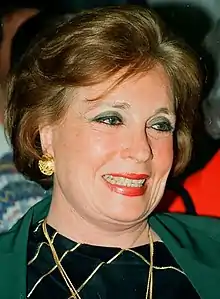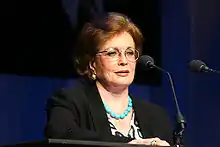Jehan Sadat
Jehan Sadat[1] (Arabic: جيهان السادات Jihān as-Sadāt,[2] [ʒeˈhæn es.sæˈdæːt]; née Safwat Raouf; born 29 August 1933), is an Egyptian human rights activist, the widow of Anwar Sadat, and was First Lady of Egypt from 1970 until her husband's assassination in 1981.
Jehan Sadat | |
|---|---|
 | |
| First Lady of Egypt | |
| In role October 15, 1970 – October 6, 1981 | |
| President | Anwar Sadat |
| Preceded by | Tahia Kazem |
| Succeeded by | Suzanne Mubarak |
| Personal details | |
| Born | Jehan Safwat Raouf (Arabic: جيهان صفوت رؤوف) 29 August 1933 Cairo, Kingdom of Egypt |
| Spouse(s) | Anwar Sadat |
| Children | 4 |
| Parents | Safwat Raouf Gladys Cotterill |
| Alma mater | Cairo University |
Early years
Jehan Sadat, also spelled Jihan, was born Jehan Safwat Raouf (Arabic: جيهان صفوت رؤوف Jīhān Ṣafwat Raʼūf [ʒeˈhæːn ˈsˤɑfwɑt ɾɑˈʔuːf])) in Cairo, Egypt, as the first girl and third child of an upper-middle-class family of an Egyptian surgeon father, Safwat Raouf, and English music teacher mother, Gladys Cotterill. Her mother was the daughter of Charles Henry Cotterill, a Sheffield City police superintendent. She was raised as a Muslim, according to her father's wishes, but also attended a Christian secondary school for girls in Cairo.
As a teenage schoolgirl, she was intrigued by Anwar Sadat as a local hero, through following reports in the media about his adventures, in addition to his courage, loyalty, and determination in resisting the British occupation of Egypt. She heard many stories about him from her cousin, whose husband was his colleague in resistance, and later in prison.
It was at her 15th birthday party that she first met her future husband Sadat, shortly after his release from prison,[3] where he had served two and a half years for his political activities.
The couple married on May 29, 1949, after some hesitation, and objections from her parents to the idea of their daughter marrying a jobless revolutionary. He was 30, while she was 15. Sadat was subsequently part of the core members of the Free Officers Movement that led the Egyptian Revolution of 1952, which overthrew the monarchy of Egypt and Sudan.
As First Lady

Over the course of 32 years, Sadat was a supportive wife for her husband, who, in his rising political career, who would go on to become President of Egypt. The couple had three daughters, Noha, Jihan, Lobna, and a son, Gamal.
Sadat became First Lady of Egypt in 1970, and used her platform to touch the lives of millions inside her country, serving as a role model for women everywhere. She helped change the world's image of Arab women during the 1970s, while undertaking volunteer work, and participating in non-governmental service to the less fortunate.
Non-governmental services
Sadat played a key role in reforming Egypt's civil rights laws during the late 1970s. Often called "Jehan's Laws", new statutes advanced by her granted women a variety of new rights, including those to alimony and custody of children in the event of divorce.
After visiting wounded soldiers at the Suez front during the Six-Day War in 1967, she founded al Wafa' Wa Amal (Faith and Hope) Rehabilitation Center, which offers disabled war veterans medical and rehabilitation services and vocational training. The center is supported by donations from around the world and now serves visually impaired children and has a worldwide known music and choir band.
She has also played crucial roles in the formation of the Talla Society, a cooperative in the Nile Delta region that assists local women in becoming self-sufficient; the Egyptian Society for Cancer Patients and the Egyptian Blood Bank; and SOS Children's Villages in Egypt, an organization that provides orphans new homes in a family environment.
She headed the Egyptian delegation to the UN International Women's Conferences in Mexico City and Copenhagen. She is founder of the Arab-African Women's League. As an activist, she has hosted and participated in numerous conferences throughout the world concerning women's issues, children's welfare, and peace in Africa, Asia, Europe, and North and South America.
On 6 October 1981, Sadat's husband was assassinated by members of the Egyptian Islamic Jihad during the annual victory parade held in Cairo to celebrate Operation Badr. This ended both his presidency and her period as First Lady, which had endured for nearly 11 years.
Education
Sadat gained a BA in Arabic Literature at Cairo University in 1977. This was followed by a MA in Comparative Literature in 1980, and PhD in Comparative Literature in 1986, both at the same university.
After completing her education, Sadat became a teacher at the Cairo Artist and Performance Center.
Later years

Sadat is a Senior fellow at the University of Maryland, College Park (where The Anwar Sadat Chair for Peace and Development has also been endowed).
She also wrote an autobiography, A Woman of Egypt (ISBN 0-7432-3708-0), published by Simon & Schuster in 1987, as well as poetry in Arabic, under a pseudonym. Her second memoir, My Hope for Peace, was released in March 2009.
Awards and honors
Sadat is the recipient of several national and international awards for public service and humanitarian efforts for women and children. She has also received more than 20 honorary doctorate degrees from national and international colleges and universities around the world. In 1993, she received the Community of Christ International Peace Award, whilst in 2001, she was the winner of the Pearl S. Buck Award.
Former positions
- Egypt's first lady from 1970 to 1981
- First woman chair of the People's Council of Munofeyya Provincial governorate
- Visiting professor at American University, University of South Carolina, and Radford University in the United States
- Professor of international studies at the University of Maryland since 1993[4]
References
- Jehan Sadat, Ph.D. official website.
- Zhīhān al-Sadāt : al-marʼah allatī ḥakamat Miṣr! WorldCat entry.
- Sadat, Jehan. Interview with Diane Rehm. "The Diane Rehm Show." Archived 2009-04-02 at the Wayback Machine National Public Radio. WAMU, Washington, DC. 2009-03-30.
- SCU.EDU
External links
| Wikimedia Commons has media related to Jehan Al Sadat. |
- Biography at the Anwar Sadat Chair for Peace and Development at the University of Maryland
- Biography at Women's International Center
- Appearances on C-SPAN
- Jehan Sadat on Charlie Rose
- Jehan Sadat at IMDb
- Works by or about Jehan Sadat in libraries (WorldCat catalog)
- Thirty years later, Sadat's widow still hopes for peace, CNN, 26 March 2009
| Honorary titles | ||
|---|---|---|
| Preceded by Tahia Kazem |
First Lady of Egypt 1970–1981 |
Succeeded by Suzanne Mubarak |